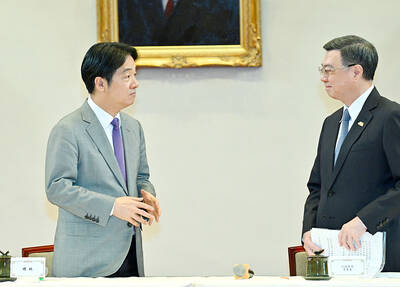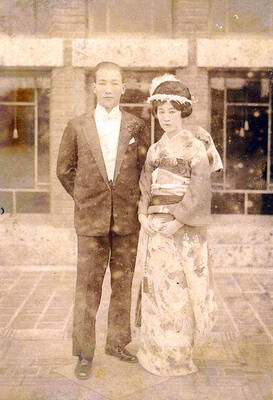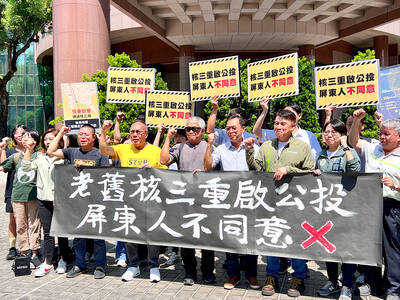For more than four decades, Old Master Q (老夫子) has worn an outfit that would not look out of place if he were transported back in time to the Qing Dynasty. But in a fashion show at W Whiskey & Wine last Wednesday, the classic comic strip character was re-imagined as a hip-hop artist and winged eyeball, among other things, by four of Taiwan’s leading young designers.
Produced by OMQ ZMedia, the comic’s publisher, and style magazine Men’s Uno, the show was one of the penultimate events in Old Master Q’s yearlong 45th anniversary celebration, which draws to a close in January. This month’s Men’s Uno also features a series of drawings with Old Master Q dressed up in the latest styles from nine fashion houses, including Gucci, Prada and Louis Vuitton.
Young Tsao (曹智揚) sent Old Master Q down the runway as a caped crusader, while singer and actor Jack Chang (張永智) dressed him as an angel with a golden face. Xiao Qing-yang (蕭青陽) imagined him as a hip-hop artist who plays the ruan (阮), a traditional Chinese lute. And artist and environmentalist Mr Eyeball (眼球先生) transformed Old Master Q into an eyeball with flowing bat sleeve wings.
The first Old Master Q comic strip was published in Hong Kong in 1962. Since then the comic, with its mixture of slapstick humor and good-natured social commentary, has become a perennial favorite among Chinese readers throughout the world, selling nearly 100 million books in a dozen countries and inspiring 12 films. The comics, created by Alfonso Wong (王家禧), follow the misadventures of Old Master Q (also referred to as Lao Fu Zi, the romanization of his Mandarin name), a traditionalist who nonetheless acts (and looks) younger than he really is, and his sidekicks Big Potato (大蕃薯) and Mr Chin (秦先生).
As part of the 45th anniversary celebration, OMQ ZMedia, the company that Alfonso Wong’s son Joseph Wong (王澤) founded to carry on his father’s legacy, published special-edition comic books, launched a series of collectible figures sold in convenience stores, celebrated the sale of original manuscripts at Sotheby’s (the first Chinese comics sold by the auction house) and collaborated with Hong Kong designers EIB Studio on a series of designer toys.
“Years ago, we thought maybe we should focus on repeating what my dad had done with the comics, but after a while, I realized that my father is an individual and what he has in him, his own talent, there is no way to recreate it. So we decided to move on with Old Master Q and put what we like and how we feel into our work,” says Wong, who is also a professor of architecture at Shih-Chien University (實踐大學).
And lately, as the collaborations with Men’s Uno demonstrate, Old Master Q feels like being a high-fashion model.
“With fashion, and any kind of design, it’s about transmitting a feeling, a feeling that is up-to-date, able to change your mind and make you happy. Comic books and fashion are the same in that way,” says Wong.
Old Master Q has been drawn in nearly 100 outfits over the years, but most readers associate him with his quirky, old-fashioned clothes: a yellow tunic, vest and loose trousers.
“A couple of years ago I decided to draw different kinds of clothing on him, like blue jeans with jackets, and I thought he looked alright. Then I tried high fashion and thought, ‘God, he looks good,’” says Wong.
Wong enjoys the challenge of drawing the characters in poses that human models can’t achieve. In one instance he had to figure out how to show off a Hermes outfit with a fur-trimmed coat over a dress and boots on Old Master Q’s love interest, Miss Chen (陳小姐).
“I thought, ‘How am I going to draw the dress?’ because with the coat on you can’t really see it. Then I thought, ‘I’ve got it!’ Old Master Q is a hypnotist, he does his magic, his girlfriend falls asleep, levitates into the air and the coat falls to the side, so you can see the lining, the dress and the orange boots,” says Wong.
When asked why Old Master Q still attracts new readers after 45 years, Wong says he has no idea.
“The only way you can know is by asking readers and maybe each reader will give you a completely different reason. But there is something there, something that they feel that they have in common with the characters or maybe they simply like the design of the comics,” says Wong.
While Old Master Q has traveled into outer space and sat down for noodles with Richard Nixon and Fidel Castro, most of the comic’s humor derives from placing Old Master Q and his friends into ridiculous situations that are inspired by the challenges of day-to-day life.
“He represents an everyday person with a job who, for example, works at an insurance company behind a desk. But that doesn’t mean he’s ordinary. He’s got imagination, he’s got desires, he’s got feelings,” says Wong.
Wong believes that comics are taken more seriously as an art form now than when his father drew the first Old Master Q comic, thanks in part to Roy Lichtenstein, Andy Warhol and other artists who created fine art based on comic book imagery.
“To us, it’s always been an art. The line quality and the shadows in the drawings are very seriously dealt with, even though to a regular person flipping through a magazine or newspaper, a comic is only four frames that take a few seconds to read,” says Wong. “But if a reader catches the humor in it, then the artist has done his job.”

Under pressure, President William Lai (賴清德) has enacted his first cabinet reshuffle. Whether it will be enough to staunch the bleeding remains to be seen. Cabinet members in the Executive Yuan almost always end up as sacrificial lambs, especially those appointed early in a president’s term. When presidents are under pressure, the cabinet is reshuffled. This is not unique to any party or president; this is the custom. This is the case in many democracies, especially parliamentary ones. In Taiwan, constitutionally the president presides over the heads of the five branches of government, each of which is confusingly translated as “president”

Sept. 1 to Sept. 7 In 1899, Kozaburo Hirai became the first documented Japanese to wed a Taiwanese under colonial rule. The soldier was partly motivated by the government’s policy of assimilating the Taiwanese population through intermarriage. While his friends and family disapproved and even mocked him, the marriage endured. By 1930, when his story appeared in Tales of Virtuous Deeds in Taiwan, Hirai had settled in his wife’s rural Changhua hometown, farming the land and integrating into local society. Similarly, Aiko Fujii, who married into the prominent Wufeng Lin Family (霧峰林家) in 1927, quickly learned Hoklo (commonly known as Taiwanese) and

The low voter turnout for the referendum on Aug. 23 shows that many Taiwanese are apathetic about nuclear energy, but there are long-term energy stakes involved that the public needs to grasp Taiwan faces an energy trilemma: soaring AI-driven demand, pressure to cut carbon and reliance on fragile fuel imports. But the nuclear referendum on Aug. 23 showed how little this registered with voters, many of whom neither see the long game nor grasp the stakes. Volunteer referendum worker Vivian Chen (陳薇安) put it bluntly: “I’ve seen many people asking what they’re voting for when they arrive to vote. They cast their vote without even doing any research.” Imagine Taiwanese voters invited to a poker table. The bet looked simple — yes or no — yet most never showed. More than two-thirds of those

In the run-up to the referendum on re-opening Pingtung County’s Ma-anshan Nuclear Power Plant last month, the media inundated us with explainers. A favorite factoid of the international media, endlessly recycled, was that Taiwan has no energy reserves for a blockade, thus necessitating re-opening the nuclear plants. As presented by the Chinese-language CommonWealth Magazine, it runs: “According to the US Department of Commerce International Trade Administration, 97.73 percent of Taiwan’s energy is imported, and estimates are that Taiwan has only 11 days of reserves available in the event of a blockade.” This factoid is not an outright lie — that